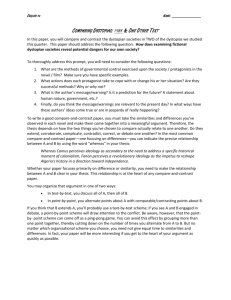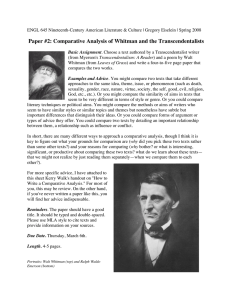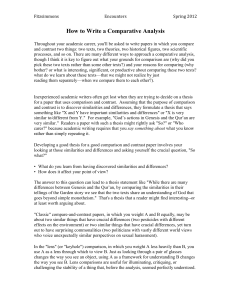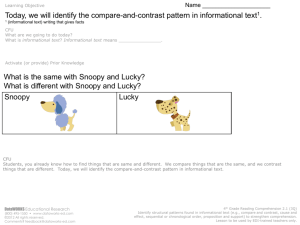How to Write a Compare-and
advertisement
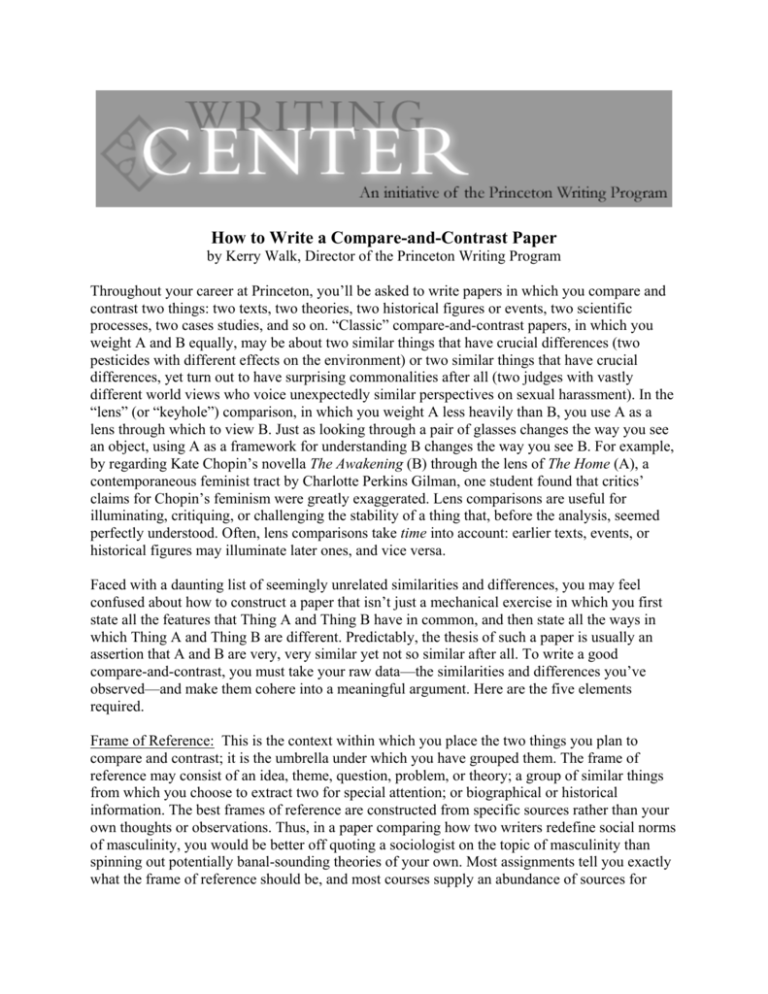
How to Write a Compare-and-Contrast Paper by Kerry Walk, Director of the Princeton Writing Program Throughout your career at Princeton, you’ll be asked to write papers in which you compare and contrast two things: two texts, two theories, two historical figures or events, two scientific processes, two cases studies, and so on. “Classic” compare-and-contrast papers, in which you weight A and B equally, may be about two similar things that have crucial differences (two pesticides with different effects on the environment) or two similar things that have crucial differences, yet turn out to have surprising commonalities after all (two judges with vastly different world views who voice unexpectedly similar perspectives on sexual harassment). In the “lens” (or “keyhole”) comparison, in which you weight A less heavily than B, you use A as a lens through which to view B. Just as looking through a pair of glasses changes the way you see an object, using A as a framework for understanding B changes the way you see B. For example, by regarding Kate Chopin’s novella The Awakening (B) through the lens of The Home (A), a contemporaneous feminist tract by Charlotte Perkins Gilman, one student found that critics’ claims for Chopin’s feminism were greatly exaggerated. Lens comparisons are useful for illuminating, critiquing, or challenging the stability of a thing that, before the analysis, seemed perfectly understood. Often, lens comparisons take time into account: earlier texts, events, or historical figures may illuminate later ones, and vice versa. Faced with a daunting list of seemingly unrelated similarities and differences, you may feel confused about how to construct a paper that isn’t just a mechanical exercise in which you first state all the features that Thing A and Thing B have in common, and then state all the ways in which Thing A and Thing B are different. Predictably, the thesis of such a paper is usually an assertion that A and B are very, very similar yet not so similar after all. To write a good compare-and-contrast, you must take your raw data—the similarities and differences you’ve observed—and make them cohere into a meaningful argument. Here are the five elements required. Frame of Reference: This is the context within which you place the two things you plan to compare and contrast; it is the umbrella under which you have grouped them. The frame of reference may consist of an idea, theme, question, problem, or theory; a group of similar things from which you choose to extract two for special attention; or biographical or historical information. The best frames of reference are constructed from specific sources rather than your own thoughts or observations. Thus, in a paper comparing how two writers redefine social norms of masculinity, you would be better off quoting a sociologist on the topic of masculinity than spinning out potentially banal-sounding theories of your own. Most assignments tell you exactly what the frame of reference should be, and most courses supply an abundance of sources for constructing it. If you encounter an assignment that fails to provide a frame of reference, you must come up with one on your own. A paper without such a context would have no angle on the material, no focus or frame for the writer to propose a meaningful argument. Grounds for Comparison: Let’s say you’re writing a paper on global food distribution, and you’ve chosen to compare apples and oranges. Why these particular fruits? Why not pears and bananas? The rationale behind your choice, the grounds for comparison, lets your reader know why you made the choice you did—why your choice is deliberate and meaningful, not random. For instance, in a paper asking how the “discourse of domesticity” has been used in the abortion debate, the grounds for comparison are obvious; the issue has two conflicting sides—pro-choice and pro-life. In a paper comparing the effects of acid rain on two forest sites, your choice of sites is less obvious. A paper focusing on similarly aged forest stands in Maine and the Catskills will be set up somewhat differently from a paper comparing a new forest stand in the White Mountains with an old one in the same region. You need to indicate the reasoning behind your choice. Thesis: The grounds for comparison anticipates the comparative nature of your thesis. As in any argumentative paper, your thesis statement will convey the gist of your argument, which necessarily follows from your frame of reference. But in a compare-and-contrast paper, the thesis depends on how the two things you’ve chosen to compare actually relate to one another. Do they extend, corroborate, complicate, contradict, correct, or debate one another? In other words, what kind of conversation are they engaged in? In the most common compare-and-contrast—one focusing on differences—you can indicate the relationship between the two things by using the word “whereas” in your thesis: Whereas Camus perceives ideology as secondary to the need to address a specific historical moment of colonialism, Fanon perceives a revolutionary ideology as the impetus to reshape Algeria’s history in a direction toward independence. Whether your paper focuses primarily on difference or similarity, you need to make the relationship between A and B clear in your thesis. This relationship is at the heart of any compare-and-contrast paper. Organizational Scheme: Your introduction includes your frame of reference, grounds for comparison, and thesis. There are two basic ways to organize the body of your paper. In text-bytext, you discuss all of A, then all of B. In point-by-point, you alternate points about A with comparable points about B. The organizational scheme you choose partly depends on how you perceive A and B to be related. If you think that B extends A, you’ll probably use a text-by-text scheme; if you see A and B engaged in debate, you may want to use a point-by-point scheme to draw attention to the conflict. Be aware, however, that the point-by-point scheme can come off as a ping-pong game. You can avoid this effect by grouping more than one point together, thereby cutting down on the number of times you alternate from A to B. You can organize a classic compare-and-contrast paper either text-by-text or point-by-point. But in a “lens” comparison, in which you spend significantly less time on A (the lens) than on B (the focal text), you almost always organize text-by-text. That’s because A and B are not strictly comparable: A is merely a tool for helping you discover whether or not B’s nature is actually what expectations have led you to believe it is. No matter which organizational scheme you choose, you need not give equal time to similarities and differences. In fact, your paper will be more interesting if you get to the heart of your argument as quickly as possible. Thus, a paper on two evolutionary theorists’ very different interpretations of specific archaeological findings might have as few as two or three sentences in the introduction on similarities and at most a paragraph or two at the beginning of the paper to set up the contrast between the theorists’ positions. The rest of the paper, whether organized text-by-text or point-by-point, will treat the two theorists’ differences. Linking A and B: All argumentative papers require you to link each point in the argument back to the thesis. Without such links, your reader will be unable to see how new sections logically and systematically advance your argument. In a compare-and-contrast paper, you also need to make links between A and B in the body of your essay if you want your paper to hold together. To make these links, use transitional expressions of comparison and contrast (similarly, moreover, likewise, on the contrary, on the other hand, whereas, by contrast, and conversely) and contrastive vocabulary (in the example below, the Old South/Northern): As a girl raised in the fading glory of the Old South, amid mystical tales of magnolias and moonlight, the mother remains part of a dying generation. Surrounded by hard times, racial conflict, and limited opportunities, Julian, on the other hand, feels repelled by the provincial nature of home, and represents a new Southerner, one who sees his native land through a condescending Northerner’s eyes. Example: A Classic Compare-and-Contrast Paper Focusing on Differences In response to an assignment asking for a comparison of two or three gothic tales, freshman Chad Hill wrote a paper about modern readers’ disbelief in ghosts and how three modern gothic storytellers negotiate this disbelief in rather different ways. In the opening paragraph, Chad uses an essay by Terry Castle to construct a frame of reference about why we no longer believe in ghosts and the implications of our skepticism. In a second introductory paragraph, Chad introduces the three stories, observing as his grounds for comparison that these recent gothic tales each reflect their authors’ modern skepticism. He ends this paragraph with a statement of his thesis, in which he relates the three texts— contrasting two (with “whereas”) and using the third to resolve the conflict. In the body of the essay, Chad offers a text-by-text-by-text analysis, deliberately linking each section not only to his thesis but to preceding sections. In the conclusion, he briefly sums up his argument, then extends it by showing how the third gothic tale actually modifies Castle’s theory, with which the paper had begun. http://www.princeton.edu/writing

